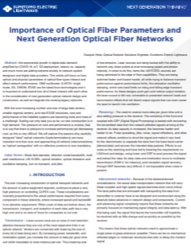
The exponential growth in digital data demand, amplified by COVID-19, IoT, 5G deployment, latency vs. capacity and much more are adding extreme anxiety to network system designers and digital data providers. This article will focus on how optical and physical parameters of optical fiber types interact and affect network performance. OM5 multimode, G.657A1 single mode, 5G, DWDM, EDGE are the latest buzz technologies and it is important to understand how all of these interact with each other in the consideration of next generation optical network design and construction, as well as integrate into existing legacy networks.
With the ever-increasing number and size of large data centers, smaller regional centers, and new EDGE structures, cost and performance of the installed systems are becoming more and more of a challenge. Scaling can only take you so far, so new construction is in high demand. The pressure on cost and performance is inverse, that is to say that there is pressure to increase performance yet decreasing cost, as this is very difficult. We will explore the reasons why carefully designed “ideal” optical networks (loads/terminations) are more important now than ever and approaching all network interconnections, as “optical waveguides” with no reflective junctions is now mandatory.
